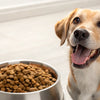Why Doesn’t My Dog Like Kibble? Understanding Your Pup's Preferences
- Houndsy
Table of Contents
- Introduction
- Understanding Your Dog's Dietary Preferences
- Solutions to Encourage Kibble Acceptance
- Exploring Alternative Diets
- Conclusion
Introduction
Have you ever set down a fresh bowl of kibble for your dog, only to watch them turn their nose up and trot away? It’s a common scenario that can leave pet owners puzzled and concerned. According to a study conducted by the American Kennel Club, nearly 20% of dog owners have reported that their pets have suddenly refused kibble at some point. This raises an important question: Why doesn’t my dog like kibble?
Understanding the reasons behind a dog's aversion to kibble is crucial for their overall health and happiness. Just as we have our preferences in food, dogs can be particular about what they eat. This blog post aims to explore the various factors that might contribute to your dog's kibble rejection, offering solutions and alternatives to ensure they receive the nutrition they need. By the end of this article, you'll gain insights into the potential causes of your dog's behavior and practical tips to entice them back to their bowl.
So, let’s dive in and uncover the reasons behind your dog’s picky eating habits and how we can enhance their feeding experience together.
Understanding Your Dog's Dietary Preferences
Dogs, like humans, have unique preferences and needs when it comes to food. While kibble is a staple in many households due to its convenience and affordability, it may not always be the best fit for every dog. Several factors can influence your dog’s interest in kibble, including taste, texture, and even health conditions.
Taste and Texture
1. Flavor Fatigue: Just as we might tire of a particular food, dogs can experience flavor fatigue from eating the same kibble day in and day out. If your dog has been on the same diet for an extended period, they may simply be seeking variety.
2. Texture Preferences: Some dogs prefer wet food to dry kibble due to its softer texture. If your dog has dental issues or sensitivity in their mouth, they may find kibble difficult or uncomfortable to eat.
Health Factors
1. Medical Issues: If your dog suddenly stops eating kibble they once enjoyed, it could signal an underlying health issue. Dental problems, gastrointestinal distress, or other medical conditions can affect their appetite. It’s always advisable to consult your veterinarian if you notice significant changes in your dog’s eating habits.
2. Sensitivity to Ingredients: Some dogs may develop sensitivities to certain ingredients in kibble, such as grains or specific protein sources. Allergies can manifest in various ways, including skin irritations or digestive upset, causing your dog to avoid their food.
Environmental Influences
1. Feeding Routine: Dogs thrive on routine, and any disruptions in their feeding schedule or environment can lead to changes in appetite. A noisy feeding area, changes in the household, or even a new pet can create stress for your dog.
2. Bowl Placement: The location of your dog’s bowl can impact their willingness to eat. If the bowl is in a high-traffic area or near loud appliances, your dog may feel uncomfortable eating there.
Solutions to Encourage Kibble Acceptance
Now that we’ve explored the reasons behind your dog’s kibble rejection, let’s discuss strategies to encourage them to eat their kibble again.
1. Add Toppers to Enhance Flavor
One effective way to entice your dog back to their kibble is by adding flavorful toppings. Here are some options to consider:
- Homemade Toppings: A spoonful of unsweetened pumpkin, a drizzle of bone broth, or a sprinkle of shredded chicken can make kibble more appealing.
- Fresh Ingredients: Mixing in fresh fruits or vegetables, such as carrots or green beans, can add both flavor and nutrition.
- Yogurt or Eggs: Plain yogurt (if your dog isn't lactose intolerant) or a cooked egg can provide a protein boost and make the meal more enticing.
2. Switch Up the Kibble
If your dog continues to avoid their kibble, consider switching to a different brand or flavor. Look for high-quality kibbles with natural ingredients that meet their nutritional needs.
- Quality Matters: As a brand dedicated to enhancing the pet feeding experience, we at Houndsy understand the importance of quality. Our Houndsy Kibble Dispenser allows for easy storage and dispensing of high-quality kibble, ensuring your dog enjoys fresh meals every time. Explore the Houndsy Kibble Dispenser here!
3. Improve Feeding Environment
Creating a positive feeding environment can significantly impact your dog’s willingness to eat.
- Quiet Space: Ensure the feeding area is calm and quiet, free from distractions and noise.
- Comfortable Bowl: Use a bowl that’s the right size for your dog. Some dogs may prefer wider or shallower bowls to avoid whisker fatigue.
4. Try Different Feeding Techniques
Experimenting with different feeding techniques can also stimulate your dog’s interest in kibble.
- Puzzle Feeders: These interactive feeders can make mealtime more engaging and fun, encouraging your dog to work for their food.
- Hand Feeding: Occasionally feeding your dog by hand can help reinforce the bond between you and stimulate their appetite.
5. Consult Your Veterinarian
If your dog’s aversion to kibble persists despite your efforts, it may be time to consult your veterinarian. They can help determine if any underlying health issues need to be addressed or suggest a more suitable diet for your dog’s needs.
Exploring Alternative Diets
While kibble is a popular choice, it’s not the only option available. If your dog consistently refuses kibble, you may want to explore alternative diets that align with their preferences.
1. Canned Dog Food
Canned dog food is often more palatable for dogs due to its rich aroma and softer texture. While it can be more expensive than kibble, many dogs find it more appealing.
2. Fresh Dog Food
Fresh dog food options have gained popularity in recent years. These meals are made with high-quality, human-grade ingredients and can be customized to meet your dog’s specific dietary needs. Fresh food can provide excellent nutrition while appealing to even the pickiest eaters.
3. Raw Food Diet
Some pet owners opt for a raw food diet, which consists of uncooked meat, bones, and vegetables. While this diet can be nutritious, it’s essential to consult with a veterinarian to ensure it’s balanced and safe for your dog.
4. Homemade Diets
Preparing homemade meals can be beneficial, but it requires careful planning to ensure nutritional balance. Consult a veterinary nutritionist to create a balanced home-cooked diet for your dog.
Conclusion
Understanding why your dog doesn’t like kibble is an important step in ensuring they receive the nutrition they need and fostering their well-being. By considering factors such as taste preferences, health issues, and environmental influences, we can take steps to encourage our dogs to enjoy their meals again.
If you find that kibble is no longer suitable for your dog, consider exploring alternative diets while keeping their health and preferences in mind. Whether you choose to add enticing toppings, switch to a different food, or invest in our Houndsy Kibble Dispenser for a consistent feeding experience, remember that every dog is unique, and their dietary needs should be met accordingly.
If you’re looking for innovative solutions to simplify your dog feeding routine, we invite you to check out our Houndsy Kibble Dispenser today!
FAQ
1. Why has my dog stopped eating kibble after eating it for years?
Changes in appetite can be caused by various factors, including health issues, flavor fatigue, or environmental changes. Consult your veterinarian if this persists.
2. Can I mix wet food with kibble?
Yes, mixing wet food with kibble can make meals more appealing to your dog. It also adds moisture, which can be beneficial for hydration.
3. Is it okay to switch my dog's food frequently?
Frequent changes in diet can cause digestive upset. If you need to switch foods, do so gradually over a week or more to allow your dog's digestive system to adjust.
4. What should I do if my dog won’t eat anything?
If your dog refuses all food, it’s crucial to consult your veterinarian to rule out any underlying health concerns.
5. How do I know if my dog has food sensitivities?
Signs of food sensitivities can include gastrointestinal upset, skin irritations, or changes in behavior. If you suspect sensitivities, consult your veterinarian for guidance on dietary changes.
By addressing your dog’s unique preferences and needs, we can create a positive feeding experience that enhances their health and happiness.













